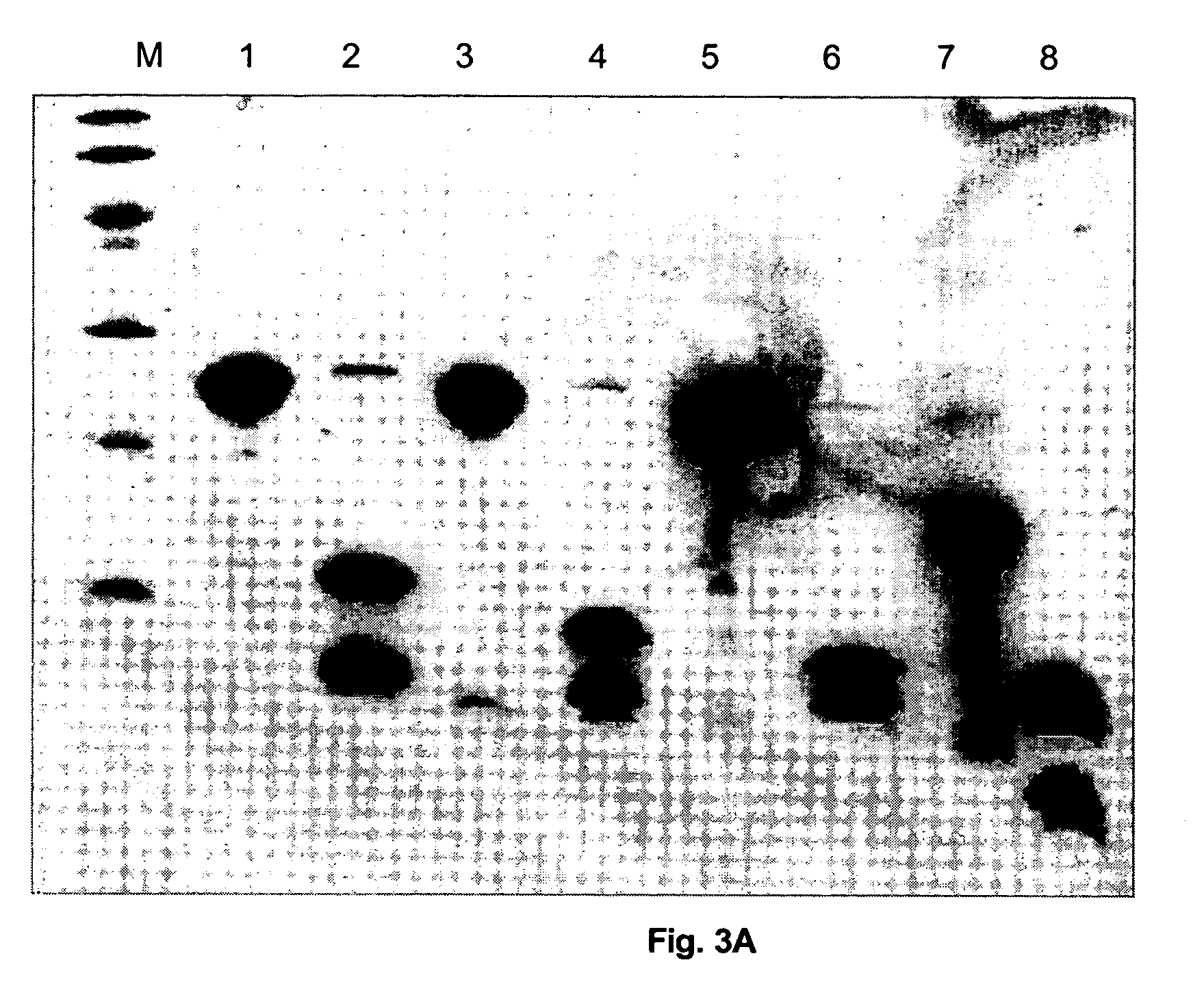Multimerised HIV fusion inhibitors
a technology of fusion inhibitors and fusion proteins, which is applied in the direction of antibody medical ingredients, peptide/protein ingredients, peptide sources, etc., can solve the problems of inability to cure hiv infection, significant increases in the expected life span of people infected, and relatively short plasma half-life of t-20, etc., to achieve efficient purification and refolding, easy to isolate and refold, and high protein yield
- Summary
- Abstract
- Description
- Claims
- Application Information
AI Technical Summary
Benefits of technology
Problems solved by technology
Method used
Image
Examples
example 2
Construction of pT7H6UB-BPFI Expression Vectors 0101, 0201, 0301 and 0401
[0075] The E. coli expression vectors pT7H6UB-BPFI-0101, -0201, and -0301 encoding the H6UB-BPFI-HR2 fusion protein fused to the Tetranectin trimerisation module derivatives E1 (SEQ ID NO 50), 110 (SEQ ID NO 59), and V17 (SEQ ID NO 65), respectively, were constructed by site directed mutagenesis of the GGT codon encoding the glycine residue number 196, 187, or 179, respectively in the corresponding fusion proteins H6UB-BPFI-0100, 0200, or -0300 to the translation stop codon TAA using the oligonucleotide primer pair FI-myc-deI-5 SEQ ID NO 34 and FI-myc-deI-3 SEQ ID NO 35 and the Quick Change Mutagenesis kit (Stratagene) as described by the manufacturer. The nucleotide sequence of the H6UB-BPFI-0101, -0201, and -0301 encoding regions were confirmed by nucleotide sequencing (SEQ ID NO: 36, 37 and 38, respectively). The amino acid sequence of the encoded fusion proteins H6-UB-BPFI-0101, -0201, and 0301 are shown ...
example 3
[0077] Production, Purification and Processing of HIV gp41 HR2 Derivatives BP-FI-0100, BP-FI-0200, BP-FI-0300, and BP-FI-0400
[0078] Construction of the T7 RNA polymerase dependent expression plasmids pT7H6-UB-FI-0100, pT7H6-UB-FI-0200, pT7H6-UB-FI-0300 (expressing trimersed fusion protein derivatives of the HIV gp41 HR2 domain with a C-terminal myc tag), and pT7H6-UB-FI-0400 (expressing monomeric HR2 fusion derivative with a C-terminal E-tag) is described in Example 1.
[0079] The fusion proteins H6-UB-FI-0100 to -0400 were produced by growing and expressing each of the expression plasmids pT7H6-UB-FI-0100 to -0400 in E. coli BL21 cells in a medium scale (6×1 litre) as described by STUDIER, et al. Journal of Molecular Biology. 1986, vol. 189, p. 113-130. Briefly, exponentially growing cultures at 37° C. were at OD600 0.8 infected with bacteriophage λ-CE6 at a multiplicity of approximately 5. One hour after infection 0.2 g of rifampicin was added to each litre of culture in order to ...
example 4
Head to Head Analysis of the HIV gp41 HR2 Derivatives BPFI-0100, -0200, -0300, and -0400 and T-20 (Fuzeon, Enfuvirtide) Anti-HIV-1 Activity In Vitro
[0083] The purified and fully processed trimeric BPFI-0100, BPFI-0200, BPFI-0300, and the monomeric BPFI-0400 fusion proteins, in 10 mM Tris-HCl pH 7.5; 0.5 M NaCl, and the commercially available synthetic peptide T-20 (Fuzeon, Roche) were analysed for their possible antiviral activity against the strain IIIB of HIV-1 using the standard human T cell lymphoblast cell line MT4 (obtained from the European Collection of Cell Cultures, ECACC). HIV-1 expression in the cell cultures were quantified indirectly by the standard MTT cell proliferation assay (R&D Systems, Abingdon, U.K.).
[0084] Briefly, HIV-1 strain IIIB (obtained from NIH AIDS Research and Reference Program) was propagated in H9 cells at 37° C., 5% CO2 in RPMI 1640 medium supplemented with 10% heat inactivated fetal calf serum and standard antibiotics. The culture supernatants w...
PUM
| Property | Measurement | Unit |
|---|---|---|
| concentration | aaaaa | aaaaa |
| temperature | aaaaa | aaaaa |
| temperature | aaaaa | aaaaa |
Abstract
Description
Claims
Application Information
 Login to View More
Login to View More - R&D
- Intellectual Property
- Life Sciences
- Materials
- Tech Scout
- Unparalleled Data Quality
- Higher Quality Content
- 60% Fewer Hallucinations
Browse by: Latest US Patents, China's latest patents, Technical Efficacy Thesaurus, Application Domain, Technology Topic, Popular Technical Reports.
© 2025 PatSnap. All rights reserved.Legal|Privacy policy|Modern Slavery Act Transparency Statement|Sitemap|About US| Contact US: help@patsnap.com



